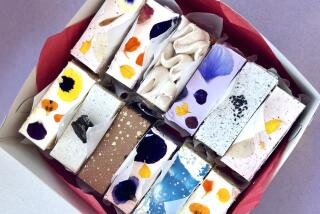Praise the Lard : Oh, Lardy Cake
- Share via
England has a lot of ghastly-sounding sweets, such as singing hinny and spotted dick, but the most repellently named of all has to be lardy cake. Forget the name, though. Lardy cake is actually a very appealing rustic pastry, something between a not-terribly-rich Danish and a very rich scone. It dates from the pre-baking-soda age, when all English cakes were yeasted, so it has the wholesome aroma of fresh bread.
In effect, it’s a risen puff pastry, and it really has to be made with lard; you could never get such a flaky result with butter. And in its defense, two ounces of lard compares favorably with the amount of butter in many a pastry with a handsomer name.
Elizabeth David published this Northumberland recipe in “English Bread and Yeast Cookery” and commented: “When using home-made pork lard (and it must be pork lard, not vegetable fat) rather than the bought variety, it is advisable that it be very cold and hard before starting to work it into the dough; it is also advisable to cool the dough in the refrigerator between turns, as for puff pastry. . . . A final and useful piece of advice comes from a little book of Hampshire recipes: ‘. . . the secret of a good lard cake is to turn it upside-down after baking so that the lard can soak through.’ ”
*
David had already observed that only very clean, pure lard can be used for any kind of bread or cake: “The slightest taint or rancidity in lard communicates itself to dough in a most disconcerting manner. If you cannot lay hands on pure pork lard, don’t attempt lardy cakes.”
NORTHUMBERLAND LARDY CAKE
1 1/2 cups flour
Salt
1/2 ounce yeast
1 teaspoon sugar
1 egg
1/2 cup milk, warm
Lardy Filling
Sift flour with dash salt and leave in warm place. Cream yeast with sugar in bowl, add egg and warmed milk and mix with flour to make soft dough. Cover and let rise in warm place until doubled in volume.
Place risen dough on floured board and roll flat. Spread 1/2 Lardy Filling onto 2/3 of dough. Starting from unfilled end, fold 1/3 of dough over Lardy Filling, then from filled end fold remaining 1/3 of dough over that, as if folding letter.
Roll out dough and spread remaining 1/2 Lardy Filling on 2/3 of dough and repeat letter-fold process. Cover and allow dough to rest in refrigerator 1/2 hour.
Remove dough from refrigerator and roll out. Fold in thirds, letter-fashion as before, then roll out and fold in same manner once more. Shape to fit 8-inch cake pan. Allow to rise, about 1 hour, until dough almost doubles in size. Bake at 350 degrees 30 to 35 minutes. Makes about 8 servings.
Each serving contains about:
220 calories; 43 mg sodium; 34 mg cholesterol; 8 grams fat; 34 grams carbohydrates; 5 grams protein; 0.22 gram fiber.
*
Lardy Filling
1/4 cup lard
1/4 cup sugar
2/3 cup currants or raisins
Cream lard and sugar together in bowl. Mix in currants.
*
Rhubarb is in season now, but any excuse will do to make a classic American pie. In modern cookbooks, such as Fanny Farmer, the crust recipe given here is likely to call for unspecified “shortening,” but lard is what gives this crust its light and flaky quality.
RHUBARB PIE
1/3 cup flour
1 1/4 to 1 1/2 cups sugar
4 cups rhubarb, cut into 1/2-inch pieces
Basic Lard Crust
Combine flour and sugar. Pour over rhubarb in mixing bowl. Stir until mixed. Let stand while making Basic Lard Crust.
On lightly floured board, roll out 1/2 of Basic Lard Crust to overlap edge of 9-inch pie plate by about 2 inches. Fit crust to pie plate. Fill with rhubarb mixture. Roll out remaining 1/2 of Basic Lard Crust into circle to cover top of pie. Place crust over rhubarb mixture. Trim edges, flute and cut air vents.
Bake pie at 425 degrees until crust is brown and juices begin to bubble in center of pie, 35 to 45 minutes. Makes 1 (9-inch) pie.
*
Basic Lard Crust
2 cups flour
1 teaspoon salt
2/3 cup cold lard
4 to 5 tablespoons ice water
Combine flour and salt in mixing bowl. Cut in lard until particles size of small peas are formed. Sprinkle water over flour mixture and stir with fork until dough forms ball. Divide dough in half.
*
Almost on a lark, we decided to substitute lard for butter in one of America’s favorite recipes--the chocolate chip cookie. After Sarah Parsons baked them in The Times Test Kitchen, the results were surprising, if a bit mixed. The larded version puffed up higher and was crisper than the one made with butter. But some tasters objected to the faint meaty taste in the background. Maybe some things were not meant to be messed with.
TOLLHOUSE COOKIES WITH A TWIST
2 1/4 cups flour
1 teaspoon baking soda
1 teaspoon salt
1 cup lard
3/4 cup granulated sugar
3/4 cup brown sugar, packed
1 teaspoon vanilla
2 eggs
1 (12-ounce) package semisweet chocolate chips
1 cup chopped nuts
Combine flour, baking soda and salt in small bowl. Set aside.
In large mixing bowl, cream lard wtih sugars and vanilla until light. Beat in eggs. Gradually add flour mixture. Stir in semisweet chocolate chips and nuts. Drop by rounded tablespoon onto lightly greased baking sheets. Bake at 350 degrees 12 to 15 minutes. Makes about 4 dozen (2 1/4-inch) cookies.
Each serving contains about:
143 calories; 93 mg sodium; 12 mg cholesterol; 8 grams fat; 11 grams carbohydrates; 1 gram protein; 0.13 gram fiber.
More to Read
Eat your way across L.A.
Get our weekly Tasting Notes newsletter for reviews, news and more.
You may occasionally receive promotional content from the Los Angeles Times.










